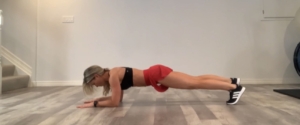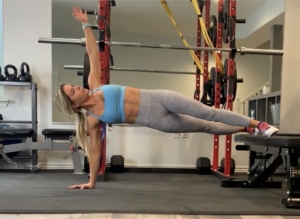Planks are one of the most effective exercises for building core strength, stability, and endurance. They engage multiple muscle groups and can be performed anywhere, making them a versatile addition to any fitness routine. In this blog, we’ll cover the proper planking form, the muscles they target, common mistakes, and variations to keep your workout fresh and challenging.
What Muscles Do Planks Work?
Planks primarily target the core muscles, but they also engage: Rectus Abdominis: The “six-pack” muscles, and many others.
- Transverse Abdominis: Deep core muscles that stabilize your spine.
- Rectus Abdominis: The muscles that run vertically along the front of your abdomen.
- Obliques: Muscles on the sides of your abdomen.
- Back Muscles: Erector spinae help maintain spinal alignment.
- Shoulders and Chest: Stabilizing muscles during the plank hold.
- Glutes and Legs: These muscles also need to be activated to maintain proper body alignment.

Proper Planking Form
A plank looks like a simple exercise for abs but there is more to it than you think to do it properly. Mastering the plank is an important strength training foundation and will help you make progress with other exercises like the push-up for example. The plank is considered an isometric move that keeps your body in static contraction ( no movement) as opposed to the lengthening and contracting phases.
Start Position:
Keep your elbows under your shoulders, balance on your toes, and maintain a neutral spine to make sure you are in the right position before starting.
- Begin in a push-up position with your hands directly under your shoulders.
- Body Alignment: Keep your body in a straight line from head to heels. Your hips should not sag or be raised too high.
Engage your core, glutes, and thighs to stabilize your body. Squeeze your shoulder blades back to keep your upper body from rounding over. - Head Position: Keep your head neutral, looking slightly ahead rather than straight down or up. It is ok to look at a spot between your hands but your neck should not be cranked up or down.
- Breathing: Breathe steadily throughout the hold. Try to take slow deep breaths.
- Duration: Aim to hold the plank for 20-60 seconds, depending on your fitness level. Gradually increase the duration as you build strength. Cut the time shorter if your form is starting to deteriorate.

Common Mistakes to Avoid
- Sagging Hips: This can lead to lower back strain. Engage your core to maintain a straight line. Think of pulling your belly up towards the ceiling.
- Raising Hips: Keeping your hips too high can reduce the effectiveness of the exercise. This can happen when you don’t quite have the core strength to hold that neutral position.
- Neck Tension: Avoid craning your neck. Keep your gaze slightly ahead to maintain a neutral spine.
- Holding Your Breath: Maintain steady breathing to keep your core engaged.
Variations to Challenge Yourself
Once you have mastered proper planking form for the standard plank, here are some more challenging moves to make the exercise harder. These exercises are more difficult because you are taking away points of contact with the ground.
Side Plank:
Shift to one side, balancing on one forearm and the side of your foot. Lift your hips off the mat. This targets the obliques and engages the shoulders, hips, glutes, and lats as well.
Plank with Shoulder Taps:
While in a plank position, tap each shoulder with the opposite hand. This exercise challenges stability and coordination.
Plank Jacks:
From the plank position, jump your feet out and in like a jumping jack. Plank Jacks add a cardio element to workout.
Plank to Push-Up:
Transition from a forearm plank to a push-up position and back. This increases strength and stability.

Plank FAQs
Got questions about how to do this exercise? Here are the answers to a few commonly asked questions. Feel free to contact me and I’ll respond with answers.
Give this a Try at Home!
Planks are a fundamental exercise that can enhance your core strength, stability, and overall fitness. By focusing on proper planking form and gradually incorporating variations, you can maximize the benefits of this powerful exercise.
Whether you’re a beginner or an experienced athlete, planks should be a staple in your workout routine. Remember to listen to your body and progress at your own pace.
1:1 Training
Want to work together to perfect your plank form? I offer 1:1 training plans for all budgets, whether you are looking for in person coaching, online, or just customized training plans, I am an ISSA Certified Personal Trainer and Health Coach, and Specialist in Sports Nutrition. I have you covered!
Contact me today about setting up a consultation call to discuss your needs.
Get More Exercise Tips and Workout Ideas via Email
Now that you know the ins and outs of planks, grab your mat and give it a try. Consistency is key, so aim to include planks in your workouts a few times a week. Happy planking!
Did you love this plank workout? Sign up to receive FitbyBrittany Email Updates and never miss another blog post!


